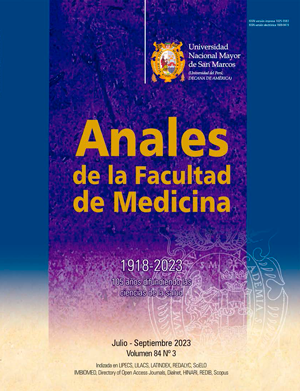Interference generated by lipemia in the measurement of biochemical constituents
DOI:
https://doi.org/10.15381/anales.v84i3.25406Keywords:
Bias, lipemia, diagnostic errors, lipoproteins, clinical chemistry testsAbstract
Turbidity due to lipemia in diagnostic samples is one of the main causes of the appearance of clinically significant biases in the measurement of biochemical magnitudes. Objective. To assess the interference by lipemia in the measurement of 25 biochemical constituents in two analyzers with dry chemistry technology (Vitros 7600®) and liquid chemistry (Atellica® Solution). Methods. Pre-experimental study with pre and post test. Increasing amounts of a parenteral nutrition lipid emulsion were added to seven aliquots of pooled sera and the influence of the interferent on 25 constituents was determined in duplicate. The relative percentage deviation of the concentration of the constituent due to the influence of turbidity with respect to a sample without interference, was calculated. Tolerance limits for interference were established using three criteria: reagent distributor, desirable systematic error, and maximum permissible error. Results. The constituents that presented the greatest biases for the liquid chemistry analyzer were: Phosphorus (-84.72%), ALT (+81.25%) and AST (-75.76%), while for the dry chemistry platform the constituents, ALT (-79.41%), CK (-28.92%) and lipase (+24.85%). Significant interference was detected in a different number of constituents according to the tolerable limit criteria used. Conclusions. The different results found according to the methodology and the analyzer used, in addition to the lack of replicability of the tests for the evaluation of interference by lipemia, originates the need to harmonize the processes and establish identical limits of tolerable interference between the laboratories and suppliers of inputs.
Downloads
Published
Issue
Section
License
Copyright (c) 2023 Anales de la Facultad de Medicina

This work is licensed under a Creative Commons Attribution-NonCommercial-ShareAlike 4.0 International License.
Those authors who have publications with this magazine accept the following terms:
- Authors will retain their copyrights and guarantee the journal the right of first publication of their work, which will be simultaneously subject to Creative Commons Attribution License that allows third parties to share the work as long as its author and its first publication this magazine are indicated.
- Authors may adopt other non-exclusive licensing agreements for the distribution of the version of the published work (eg, deposit it in an institutional electronic file or publish it in a monographic volume) provided that the initial publication in this magazine is indicated.
- Authors are allowed and recommended to disseminate their work over the Internet (eg: in institutional telematic archives or on their website) before and during the submission process, which It can produce interesting exchanges and increase quotes from the published work. (See El efecto del acceso abierto ).















